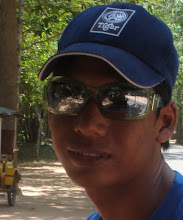Siem Reap City is the capital of Siem Reap Province, Cambodia.
Siem Reap has colonial and Chinese-style architecture in the Old French Quarter, and around the Old Market. In town, there are Apsara dance performances, craft shops, silk farms, rice-paddy countryside, fishing villages and a bird sanctuary near the Tonle Sap Lake. It is the gateway city for nearby Angkor Wat.
Siem Reap today, being a popular tourist destination, has a large number of hotels and restaurants. Most smaller establishments are concentrated around the Old Market area, while more expensive hotels are located between Siem Reap-Angkor International Airport and the town along National Road 6. There are a variety of mid-range hotels and restaurants along Sivatha, and budget to mid-range hotels in the Phsar Leu area.
History
The name Siem Reap means the 'Defeat of Siam' —today’s Thailand —and refers to a century-old bloodbath, commemorated in stone in the celebrated bas relief carvings of the monuments. The name has also been translated as 'The Brilliance of Siam', as, for nearly 500 years, before the massacre, it was one of the main border crossings from Ancient Cambodia into Siam.
In 1901 the École Française d'Extrême Orient (EFEO) began a long association with Angkor by funding an expedition into Siam to the Bayon. In 1907 Angkor, which had been taken from Siam (Thailand) by force, was assigned to Cambodia. The EFEO took responsibility for clearing and restoring the whole site. In the same year, the first tourists arrived in Angkor - an unprecedented 200 of them in three months. Angkor had been 'rescued' from the jungle and was assuming its place in the modern world.
Siem Reap, Battambang & Preah Vihear received by King Sisowath, 1907.
Siem Reap was little more than a village when the first French explorers re-discovered Angkor in the 19th century. With the acquisition of Angkor by the French, in 1907, Siem Reap began to grow, absorbing the first wave of tourists. The Grand Hotel d'Angkor opened its doors in 1929 and the temples of Angkor remained one of Asia's leading draws until the late 1960s, luring visitors like Charlie Chaplin and Jackie Kennedy. In 1975, the population of Siem Reap, along with that of the rest of the cities and towns in Cambodia, was evacuated by the communist Khmer Rouge and driven into the countryside.
As with the rest of the country, Siem Reap's history (and the memories of its people) is coloured by spectre of the brutal Khmer Rouge Regime, though since Pol Pot's death in 1998, relative stability and a rejuvenated tourist industry have been important steps in an important, if tentative, journey forward to recovery. With the advent of war, Siem Reap entered a long slumber from which it only began to awake in the mid-1990s.
Today, Siem Reap is undoubtedly Cambodia's fastest growing city and serves as a small charming gateway town to the world famous heritage of the Angkor temples. Thanks to those attractions, Siem Reap has transformed itself into a major tourist hub. Siem Reap nowadays is a vibrant town with modern hotels and architectures. Despite international influences, Siem Reap and its people have conserved much of the town's image, culture and traditions.
The town is a cluster of small villages along the Siem Reap River. These villages were originally developed around Buddhist pagodas (Wat) which are almost evenly spaced along the river from Wat Preah En Kau Sei in the north to Wat Phnom Krom in the south, where the Siem Reap River meets the great Tonle Sap Lake.
The main town is concentrated around Sivutha Street and the Psar Chas area (Old Market area) where there are old colonial buildings, shopping and commercial districts. The Wat Bo area is now full of guesthouses and restaurants while the Psar Leu area is often crowded with jewellery and handicraft shops, selling from ruby to woodcarving. Other fast developing areas are the airport road and main road to Angkor where a number of large hotels and resorts can be found.
Labels:
Siem Reap
About Siam Reap
- Angkor (2)
- Chong Khneas (Floating Village) (1)
- Prek Toal Bird Sanctuary (1)
- Siem Reap (2)
- Tonle Sap Exhibition (1)
- Tonle Sap Lake (1)
- Traditional Khmer Performance (1)
Search
Powered by Blogger.
About Me

- Plet
- My name is BunHorn but you can call me by my nickname: Plet. I work as a tuk-tuk driver in Siem Reap - Cambodia and I would like to show you in this site the wonders of my beautiful country! We wait you visit!

